What Are Fly Fishing Tackle Bags?
Fly fishing tackle bags are essential for organizing and carrying fishing gear. Anglers use them to keep fly fishing equipment safe, dry, and accessible. These bags are specifically designed to handle the unique requirements of fly fishing.
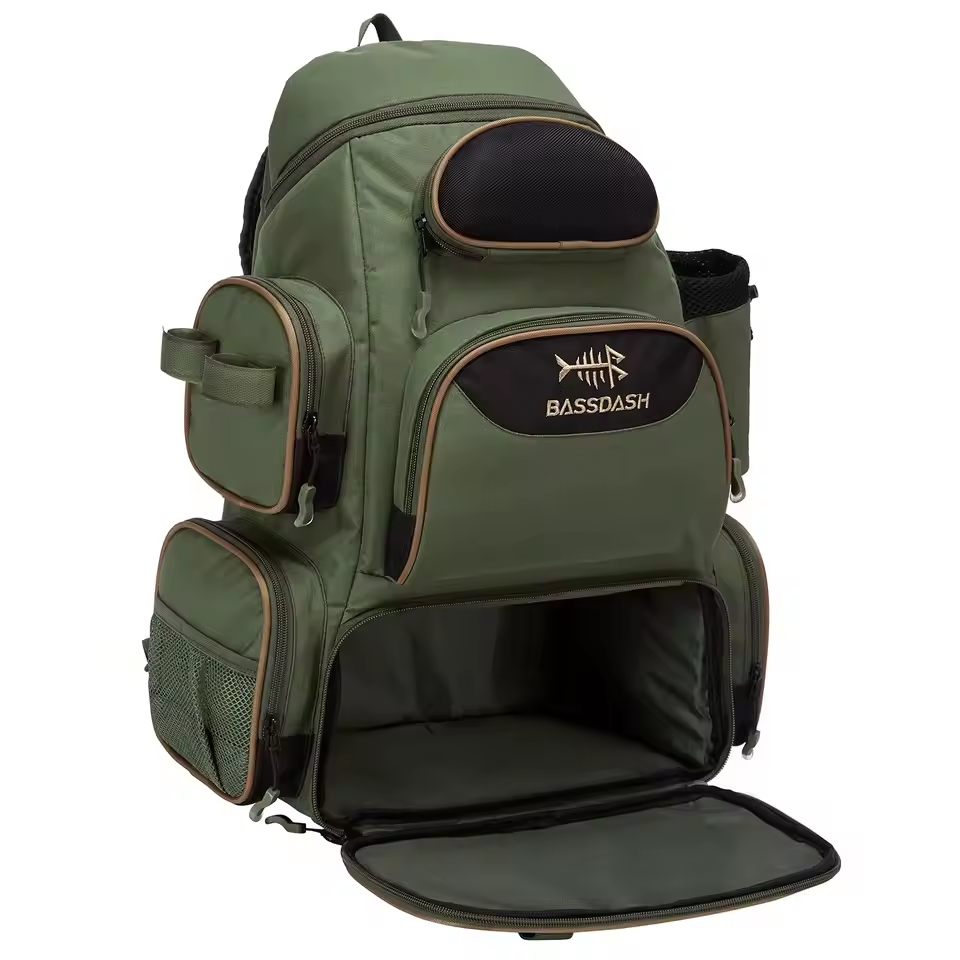
Overview of Fly Fishing Tackle Bags
Fly fishing tackle bags come in various designs to suit different fishing environments. These bags are compact, lightweight, and easy to carry. Many include padded straps and ergonomic designs for added comfort. They feature compartments to store flies, lines, reels, and other tools. Some tackle bags are waterproof, making them ideal for wading in rivers or streams. Their design focuses on durability, ensuring they withstand outdoor adventures.
Key Features to Consider
When choosing a fly fishing tackle bag, consider the following key features:
- Size and Capacity: Ensure the bag fits all your gear without being too bulky.
- Durable Materials: Look for bags made from tear-resistant and waterproof fabrics.
- Compartments: Opt for bags with multiple compartments for an organized setup.
- Ease of Access: Bags with easily accessible pockets save time during fishing.
- Comfort: Adjustable straps and ergonomic designs improve comfort during long fishing trips.
- Waterproofing: Waterproof bags protect gear from water damage, especially when wading.
A thoughtful choice ensures the tackle bag meets your specific fly fishing needs while lasting for years.
Types of Fly Fishing Tackle Bags
Fly fishing tackle bags come in different styles to suit various preferences and environments. Each style has unique features, making them versatile for anglers. Below are the four main types of fly fishing tackle bags, their benefits, and uses.
Sling Bags
Sling bags are trendy among modern fly fishers. They are lightweight and easy to swing around. Anglers wear them on one shoulder, allowing quick access to gear without removing the bag. They often include multiple compartments for organizing flies, leaders, and tools. Sling bags are ideal for short fishing trips or active anglers who prefer minimal gear.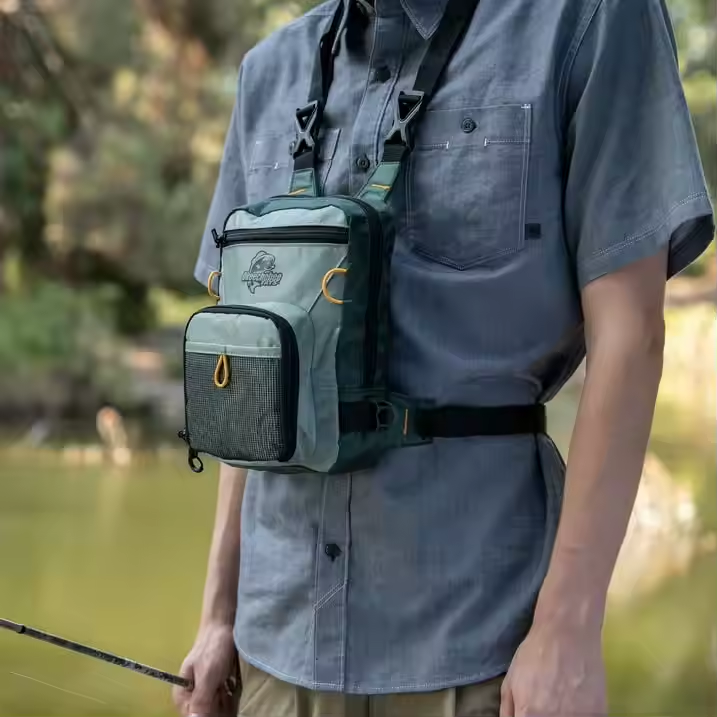
Backpack Style Tackle Bags
Backpack tackle bags are larger and suited for longer fishing trips. They offer ample storage space for extra gear, snacks, and water. These bags often feature padded straps for comfort and weight distribution. Backpack style bags are great for anglers fishing in remote areas who need to carry more equipment. Some designs even include hydration packs or rod holders for added convenience.
Chest Packs
Chest packs are compact bags worn on the front for easy accessibility. They provide just enough space for essential gear like flies, tippets, and pliers. Chest packs are perfect for anglers who wade in rivers and need quick access to tools. Their ergonomic design ensures the wearer remains comfortable even during prolonged use.
Waist Packs
Waist packs are small, belt-like bags worn around the waist. They allow hands-free fishing while keeping gear within reach. Most come with multiple pockets to organize smaller accessories. Waist packs suit anglers who prefer minimal gear and expect to stay mobile throughout the day. They are great for shallow wading or fishing in calm waters.
Materials and Durability
Selecting the right materials ensures your fly fishing tackle bag lasts through harsh conditions.
Common Materials Used
Fly fishing tackle bags are often made with durable and resilient fabrics. Some common materials include:
- Nylon: Lightweight and tear-resistant, ideal for frequent use.
- Polyester: Affordable and robust, resistant to wear and abrasion.
- Canvas: Traditional choice, very durable but heavier.
- PVC: Used for waterproof designs, great for protecting gear in wet conditions.
- Mesh Panels: Added for breathability and to dry wet items quickly.
These materials are chosen for their ability to endure outdoor environments and offer reliable performance.
Importance of Waterproof and Breathable Fabrics
Waterproofing is critical for fly fishing tackle bags. It protects your gear from getting wet. Many bags use coated fabrics or sealed zippers to prevent water entry. These features are key when fishing in rivers or rainy weather.
Breathable fabrics also play a role. They let moisture escape and ensure air circulation. This prevents mold and maintains the quality of your stored gear. Combining waterproof and breathable materials ensures your tackle bag performs well in all conditions.
Storage and Organization
Fly fishing tackle bags excel in keeping gear tidy and accessible. Proper storage and organization make fishing trips smoother by reducing clutter and saving time. These bags are designed with features that keep your equipment secure and within reach. Understanding how to use compartments and strategies for organization ensures your gear remains in top condition.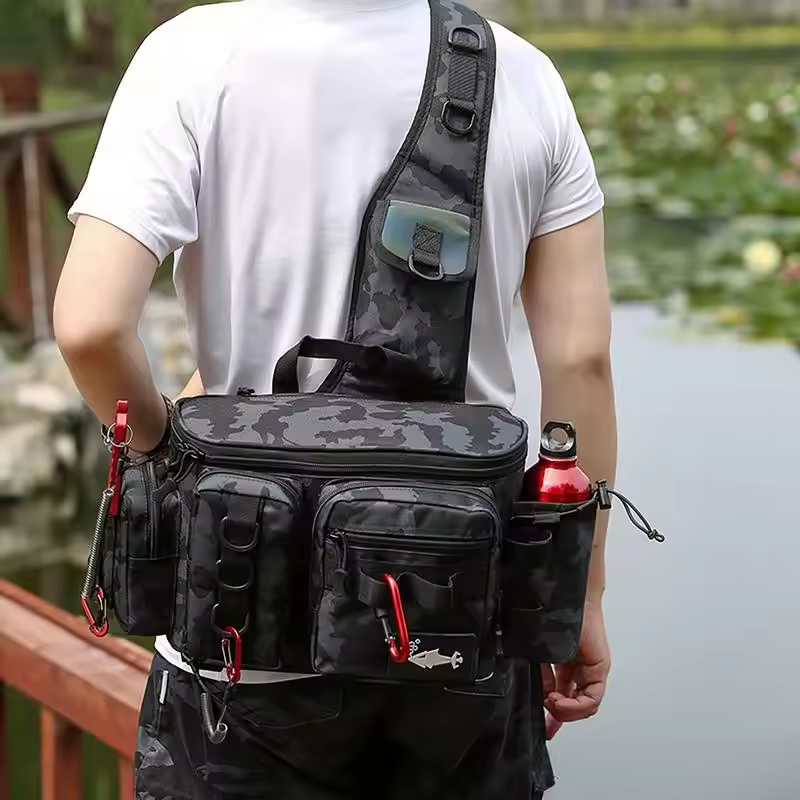
Compartments and Pockets
Compartments and pockets are essential in a well-designed fly fishing tackle bag. Here’s why:
- Separation of Gear: Multiple compartments keep different tools and accessories separate. For example, flies, tippets, and reels can each have their dedicated section.
- Quick Access: Specialized pockets allow quick access to frequently used tools such as pliers or leaders. This can be crucial when you’re changing lures or fixing lines.
- Protective Compartments: Padded sections can provide added protection for delicate items like reels or fly boxes.
- Expandable Storage: Some bags have expandable compartments for extra gear or larger items.
- Mesh Pockets: These allow wet gear to dry quicker, reducing the chances of mold or mildew.
Having the right layout in your tackle bag ensures every item has its place for ease of use and protection.
Tips for Organizing Tackle Gear
Efficient organization keeps your fishing trip hassle-free. Consider these tips:
- Sort Gear by Usage: Place frequently used items in easily accessible compartments or pockets. Store less-used gear deeper in the bag.
- Use Tackle Boxes: Small tackle boxes help group similar items together, like flies or hooks. Place them in dedicated compartments.
- Label Sections: Labeling pockets and compartments can save time when searching for specific tools.
- Roll Small Items: Roll leaders, tippets, and lines to prevent tangling. Use elastics to hold rolled items in place.
- Keep it Light: Avoid overloading your bag. Carry only the essentials to maintain comfort and mobility.
- Dry Wet Gear: If you store wet gear, use mesh pockets or separate sections to keep the rest of your bag dry.
- Regularly Declutter: After each trip, go through your bag and remove unnecessary items or trash.
With these tips, your fly fishing tackle bag can stay organized and functional, preventing frustration on the water and ensuring you enjoy your fishing adventure to the fullest.
Choosing the Right Tackle Bag for Your Needs
When selecting the perfect fly fishing tackle bag, your choice must align with your specific requirements. A well-chosen bag ensures your gear stays organized, protected, and ready for action. Key factors such as size, capacity, and specialized features for fly fishing play a major role in making the right decision.
Size and Capacity
The size and capacity of a tackle bag are fundamental considerations. They determine how much gear you can carry without sacrificing comfort. Here’s what to keep in mind:
- Gear Inventory: Assess how much gear you typically bring, including flies, reels, and tools.
- Trip Duration: For longer trips, choose larger bags to accommodate extra items like snacks and water.
- Avoid Overloading: Pick a bag that balances capacity and ease of transportation. A bulky bag can hinder mobility.
- Expandable Options: Some bags offer expandable compartments for additional storage when needed.
Ensure your bag fits all essentials without making it unwieldy or uncomfortable. Proper sizing will support both convenience and efficiency.
Specific Needs for Fly Fishing Gear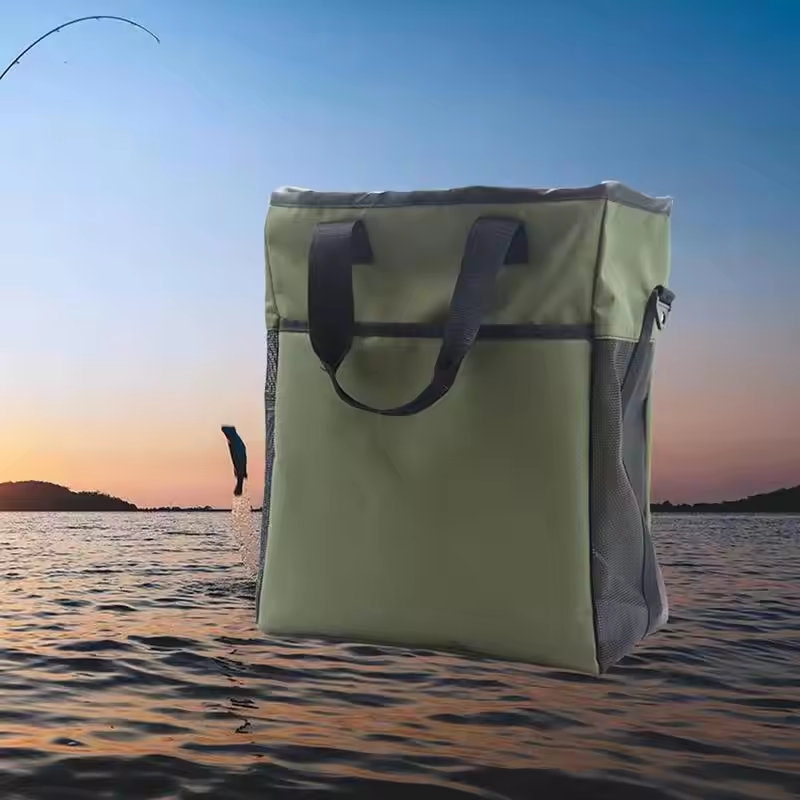
Fly fishing requires unique tools and supplies, and the bag you choose should cater to these needs. Features tailored for fly fishing gear can make your trips more enjoyable:
- Multiple Compartments: Choose a bag with compartments for separating flies, leaders, tippets, and tools. This avoids tangling and makes access easier.
- Waterproofing: Fly fishing involves water exposure, so waterproof materials are essential to protect your gear.
- Easy Access: Look for bags with front-facing or side pockets for quick retrieval of commonly used tools.
- Reel Protection: Padded sections ensure reels and delicate items remain safe.
- Hands-Free Options: Consider sling bags, chest packs, or waist packs for better mobility.
- Additional Features: Extras like rod holders or hydration compartments can be highly beneficial.
By considering these factors, you’ll find a tackle bag that meets your fly fishing needs perfectly. The right bag boosts efficiency, keeps you organized, and adds value to your fishing adventures.
Popular Brands and Models
Choosing the right fly fishing tackle bag often comes down to trusted brands and models. Reliable brands offer quality, durability, and innovative features. Many models cater to diverse needs, ensuring every angler finds a suitable option.
Top-Rated Tackle Bags for Fly Fishing
Here are some popular tackle bags that stand out:
- Simms Dry Creek Z Sling Pack: This sling-style bag is waterproof, lightweight, and offers ample storage. Its ergonomic design enables angler comfort and quick gear access.
- Fishpond Summit Sling: Known for its durability, this sling bag has a spacious layout and specialized compartments. It works well for short trips while organizing gear efficiently.
- Orvis Chest Pack: Compact and functional, this chest pack focuses on easy accessibility. It’s ideal for wading anglers who need hands-free fishing.
- Cabela’s Advanced Angler Backpack: With significant capacity, this backpack can store gear for long trips. Features like padded straps and rod holders add convenience.
- Patagonia Stormfront Hip Pack: This waist pack is completely waterproof. It’s great for shallow wading and protects gear.
These models are top picks for their practicality, materials, and comfort.
Comparing Price Points and Features
Fly fishing tackle bags vary significantly in price and features. Here are factors to consider:
- Budget-Friendly Options:
- Affordable models like basic sling or waist packs are great for beginners.
- These provide essential compartments and reasonable durability without breaking the bank.
- Mid-Range Bags:
- Bags in this range often offer waterproofing and better padding for comfort.
- Options like Fishpond or Orvis tackle bags feature higher-quality materials and ergonomic designs.
- Premium Tackle Bags:
- These bags, like Simms Dry Creek models, provide extensive features and top-tier construction.
- They are ideal for experienced anglers seeking durability and specialized features.
- Feature Comparison:
- Waterproofing matters most for wading or rainy conditions.
- Look for bags with compartments tailored for fly fishing gear.
- Comfort features, such as padded straps and ergonomic designs, enhance usability.
- Specialized add-ons like rod holders or hydration compartments can make a difference.
Evaluating features against price ensures you choose a bag that fits your needs and budget.
Maintenance and Care of Tackle Bags
Taking care of your fly fishing tackle bag helps it last longer and function efficiently. Regular maintenance prevents wear and tear and ensures your bag stays in great condition.
Cleaning Tips
Proper cleaning keeps your tackle bag in good shape. Follow these easy steps:
- Empty the Bag: Remove all gear and debris to clear the compartments.
- Shake off Dirt: Shake the bag outdoors to remove dust and loose dirt.
- Spot Clean: Use a damp cloth to clean stains or muddy areas gently.
- Use Mild Soap: For tough stains, apply mild soap and water with a soft brush.
- Rinse Thoroughly: Wipe off all soap residue to avoid damage to the fabric.
- Dry Completely: Leave the bag in a non-humid area to air dry fully. Avoid direct sunlight.
Keeping your bag clean prevents mold, odors, and material deterioration over time.
Prolonging the Lifespan of Your Bag
Taking preventive measures can help extend the lifespan of your tackle bag. Here are some tips:
- Store Properly: Keep the bag in a dry, cool space away from harsh temperatures.
- Avoid Overloading: Don’t overfill the bag to prevent stress on seams and straps.
- Repair Quickly: Fix small tears or broken zippers immediately to prevent further damage.
- Protect from Chemicals: Avoid contact with gasoline or harsh cleaning agents.
- Use Waterproof Spray: Apply a waterproofing spray for added protection against water exposure.
- Regular Inspection: Check the bag for wear and tear after each fishing trip.
With these care strategies, your fly fishing tackle bag will support you for many fishing adventures.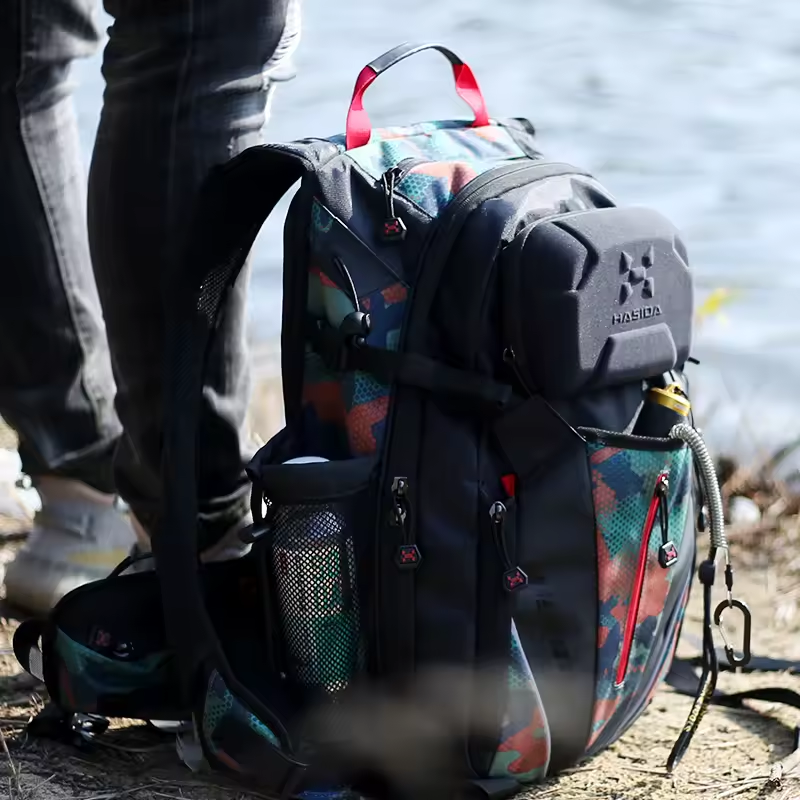
FAQs About Fly Fishing Tackle Bags
Common Questions and Answers
What makes a fly fishing tackle bag different from other fishing bags?
Fly fishing tackle bags are tailored for fly fishing gear. They have compartments for flies, reels, and lines. Many are waterproof to suit water-based environments like rivers and streams.
Can I use a regular backpack for fly fishing gear?
Regular backpacks lack specialized compartments for fly fishing tools. Waterproofing, quick access pockets, and comfort features are essential for fly fishing.
How important is waterproofing in a tackle bag?
Waterproofing is crucial for protecting fishing gear from water damage. It’s especially needed when wading through rivers or fishing during rain.
Do sling bags hold enough gear for long fishing trips?
Sling bags are best for short trips. For longer outings, backpacks provide more storage for gear, snacks, and drinks.
What should I consider when choosing a tackle bag as a beginner?
Start with a bag that offers simple organization, waterproofing, and comfort. Sling or waist packs are ideal for beginners.
Expert Tips for Beginners
- Prioritize Waterproof Bags: Avoid gear damage by choosing a tackle bag with strong waterproof features.
- Start Small: Select compact bags like sling or waist packs for easier handling during initial trips.
- Organize Gear by Sections: Use compartments to separate gear such as flies, lines, and tools. This simplifies retrieval.
- Check Comfort Features: Pick bags with padded straps or ergonomic designs for long fishing days.
- Learn Bag Maintenance: Clean and dry your bag after every trip to prevent mold and damage.
- Pack Only Essentials: Avoid overloading your bag as a beginner. Carry the basics to keep fishing simple and enjoyable.
These tips help new anglers select, organize, and maintain tackle bags effectively.